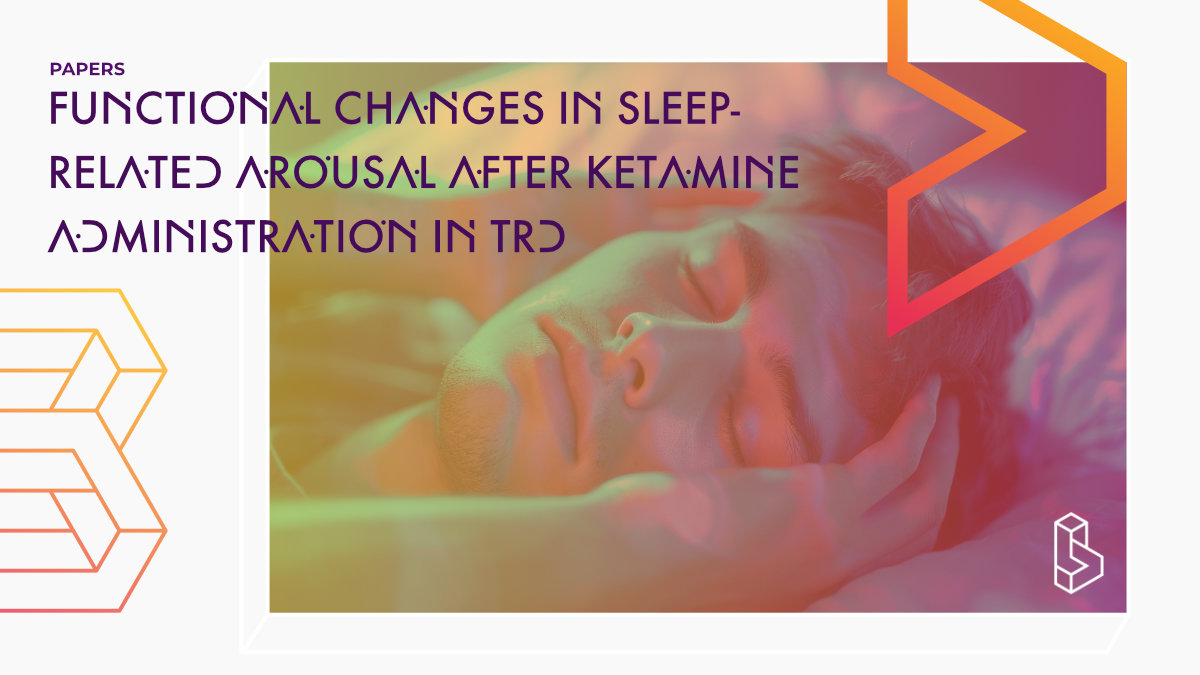This secondary analysis of a randomized, double-blind, crossover trial (n=61) evaluates the impact of ketamine on sleep metrics in individuals with treatment-resistant depression (TRD) compared to healthy volunteers (HVs). It finds that while ketamine affects delta and alpha power during sleep, it does not significantly alter sleep macroarchitecture or mediate its antidepressant and anti-suicidal effects through sleep variables.
Abstract of Functional changes in sleep-related arousal after ketamine administration in individuals with treatment-resistant depression
“The glutamatergic modulator ketamine is associated with changes in sleep, depression, and suicidal ideation (SI). This study sought to evaluate differences in arousal-related sleep metrics between 36 individuals with treatment-resistant major depression (TRD) and 25 healthy volunteers (HVs). It also sought to determine whether ketamine normalizes arousal in individuals with TRD and whether ketamine’s effects on arousal mediate its antidepressant and anti-SI effects. This was a secondary analysis of a biomarker-focused, randomized, double-blind, crossover trial of ketamine (0.5 mg/kg) compared to saline placebo. Polysomnography (PSG) studies were conducted one day before and one day after ketamine/placebo infusions. Sleep arousal was measured using spectral power functions over time including alpha (quiet wakefulness), beta (alert wakefulness), and delta (deep sleep) power, as well as macroarchitecture variables, including wakefulness after sleep onset (WASO), total sleep time (TST), rapid eye movement (REM) latency, and Post-Sleep Onset Sleep Efficiency (PSOSE). At baseline, diagnostic differences in sleep macroarchitecture included lower TST (p = 0.006) and shorter REM latency (p = 0.04) in the TRD versus HV group. Ketamine’s temporal dynamic effects (relative to placebo) in TRD included increased delta power earlier in the night and increased alpha and delta power later in the night. However, there were no significant diagnostic differences in temporal patterns of alpha, beta, or delta power, no ketamine effects on sleep macroarchitecture arousal metrics, and no mediation effects of sleep variables on ketamine’s antidepressant or anti-SI effects. These results highlight the role of sleep-related variables as part of the systemic neurobiological changes initiated after ketamine administration. Clinical Trials Identifier: NCT00088699.”
Authors: Elizabeth D. Ballard, Deanna Greenstein, Philip T. Reiss, Ciprian M. Crainiceanu, Erjia Cui, Wallace C. Duncan Jr., Nadia S. Hejazi & Carlos A. Zarate Jr.
Summary of Functional changes in sleep-related arousal after ketamine administration in individuals with treatment-resistant depression
The glutamatergic modulator ketamine is associated with rapid reductions in both depressive symptoms and suicidal thoughts, as well as transient, systemic changes across a range of biomarkers at the neuroimaging, metabolic, and neurotrophic levels. These findings have led to homeostatic theories of ketamine’s mechanism of action.
MDD is associated with sleep disturbances, including less continuous sleep, less “deep” sleep, and increased rapid eye movement (REM) pressure. Individuals with MDD are also likely to have co-morbid insomnia, which is thought to be caused by sleep-related hyperarousal or an imbalance between sleep- and wake-promoting neural circuits.
A growing body of research has implicated sleep hyperarousal as a critical risk factor for suicide. Ketamine has been shown to improve sleep physiology, depression, and suicidal ideation, but its impact on sleep-arousal markers remains undefined.
Find this paper
https://doi.org/10.1038/s41398-024-02956-2
Open Access | Google Scholar | Backup | 🕊
Cite this paper (APA)
Ballard, E. D., Greenstein, D., Reiss, P. T., Crainiceanu, C. M., Cui, E., Duncan Jr, W. C., ... & Zarate Jr, C. A. (2024). Functional changes in sleep-related arousal after ketamine administration in individuals with treatment-resistant depression. Translational Psychiatry, 14(1), 238.
Study details
Compounds studied
Ketamine
Placebo
Topics studied
Treatment-Resistant Depression
Depression
Healthy Subjects
Study characteristics
Placebo-Controlled
Double-Blind
Randomized
Re-analysis
Bio/Neuro
Participants
61
Humans
Linked Clinical Trial
Rapid Antidepressant Effects of Ketamine in Major DepressionThis study examines whether ketamine can cause a rapid-next day antidepressant effect in patients with Major Depressive Disorder.

